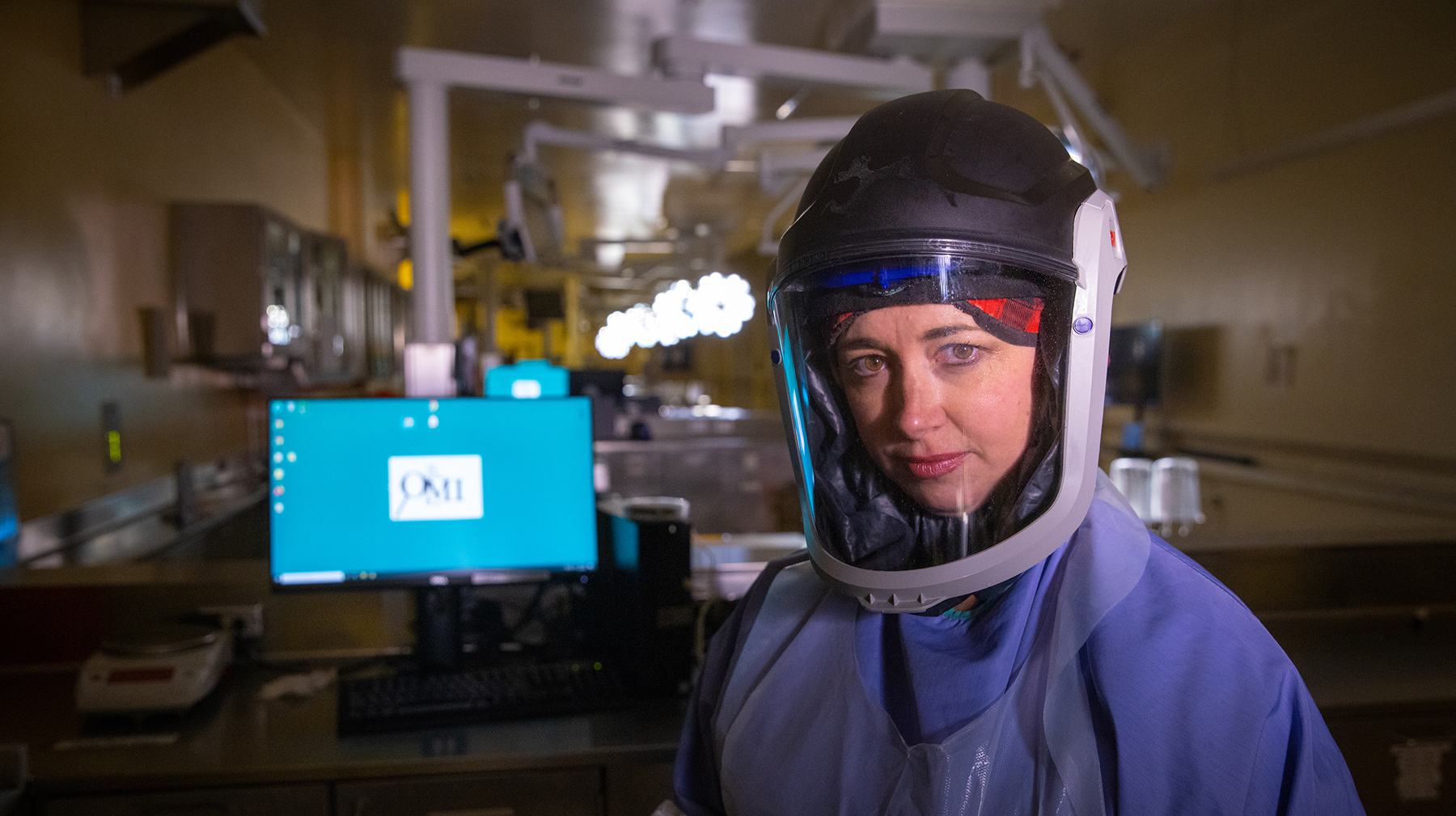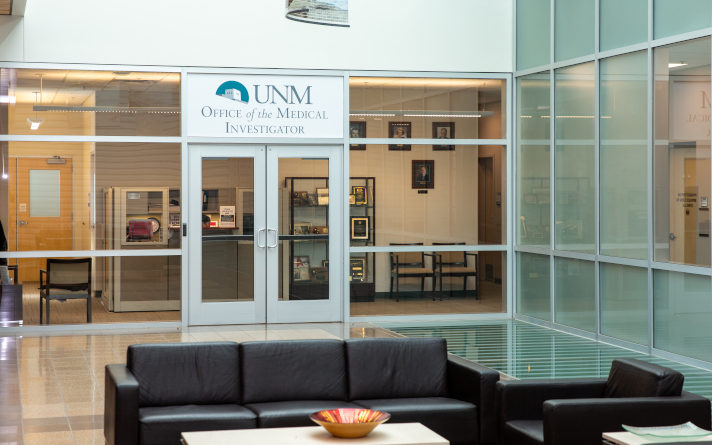Preparing for Disaster: UNM Hospital Participates in Region-Wide Emergency Training

In Search of Answers
OMI Chief Heather Jarrell Aims to Foster Interest in Forensic Pathology
Finding peace for a grieving family is one of the most satisfying parts of Heather Jarrell’s work as a neuropathologist and chief medical examiner for the state Office of the Medical Investigator at The University of New Mexico.
“I think the most intriguing cases are the ones where you are really able to put the pieces together and figure out why the person died so you're able to give the family answers,” she says.
“In a lot of what we do, it's obvious why the person died, such as a motor vehicle collision, or if a person was shot or if a person was stabbed, but there's cases where you really don't have an idea why the person died. But because you do the autopsy, you're able to find those pieces that fit together and really give the family some answers, and you can really help them with their grieving process.”
Recently, Jarrell stood at OMI’s autopsy table No. 10 and talked about her deep respect for the families who’ve lost a loved one and required an autopsy.
On the days she conducts autopsies, she wears protective gear, including a Verisafe helmet with an oxygen tube that runs from it to a device attached to her waist. It’s a purified air-powered respirator – a “PAPR” for short.
She was named interim chief of the Office of the Medical Investigator in April 2020 as the pandemic was taking hold, and permanent chief in January. Although the past year has been particularly trying, she says her team has really pulled together and filled in for each other as needed.
The OMI staff was already prepared for the pandemic by having a Biosafety Level 3 autopsy suite, having used it in previous years when cases of hantavirus appeared in New Mexico and neighboring states.
“When many of the medical examiners in the country were scrambling to figure out what protective equipment they needed . . . we were already well equipped to be able to do an autopsy on someone who died from COVID-19,” Jarrell says. “We didn't have the panic that some of the other offices might have had when the pandemic started, because we knew that we could handle that.”
OMI has 16 autopsy tables, each equipped with many tools, including heavy-duty garden clippers, ladles and spatulas. They are the among the items used to aid in determining cause of death when someone dies unexpectedly or in a violent manner.
“We were also facing our other cases, including those from the opioid epidemic and deaths due to the violence,” Jarrell says. “It has been very, very challenging throughout the year with handling increased infectious disease cases, as well as an increase in all of our other cases.”
While refrigerator trucks aren’t usually a common sight outside the OMI building, which sits on Camino de Salud adjacent to the I-25 frontage road, as many as 10 were parked at the peak of the pandemic because it was the holding facility for the whole state, says OMI administrator Anthony Cervantes.
In addition to chief medical examiner, Jarrell is director of neuropathology and associate professor of pathology in the UNM School of Medicine.
She is also believed to be the only neuropathologist between Dallas and Los Angeles who conducts autopsies where infectious prion disease is suspected. Those particular autopsies have to be conducted in a special room that has to be decontaminated after the autopsy because of its infectiousness.

[When] you do the autopsy, you're able to find those pieces that fit together and really give the family some answers, and you can really help them with their grieving process.
When Jarrell was a girl, she loved science. She paired that with her admiration for her dad, who was a Georgia state trooper, and found the ideal job in forensic pathology.
“I would always hear stories about what was going on with him and his career,” Jarrell says. “And then it just seemed in some tangential way that I could connect the two fields together. Although having practiced forensics for so long, it's really just your scientific practice, but it's very intriguing.”
Jarrell, 40, is one of more than 300 female board-certified forensic pathologists in the country, according to Kathryn Pinneri, MD, vice president of the National Association of Medical Examiners. Jarrell began working at OMI in 2014 after she completed her fellowship training in forensic pathology and has called New Mexico home since then.
Jarrell, who describes herself as an introvert, has two children. She enjoys long runs in the North Valley, likes to cook and plays piano to unwind.
“We see a lot of very violent deaths,” she says. “We see a lot of very traumatic things and people have to realize that we're not robots. At the end of the day, we go home and hug our families, too.”
Growing up in Georgia and then attending residency and fellowship training in Virginia, Jarrell’s move to New Mexico’s dry climate came as quite a shock.
“It took me quite a while just to acclimate after having lived on the East Coast my whole life before then,” Jarrell says. “I think the biggest difference for me was, how green Virginia is and how brown and light green the landscape is in New Mexico. Just adjusting to that was pretty huge for me.”
Not being able to see the sky was the norm back home because the tree canopy “just takes over and you can't see the sky,” she says. “I found that to be very soothing and very sheltering.” New Mexico’s big, blue skies took some getting used to, but the sunsets are the most beautiful she’s seen, she adds.

Want to learn more about OMI?
Find out more about the Office of the Medical Investigator on their websiteOne thing Jarrell would like to see change in the field of pathology is an increase in the number of forensic pathologists. UNM has one of the most prolific programs in the country, with four graduates each year. To complete a fellowship in forensic pathology, fellows must complete 250 autopsies in a year.
Currently, there’s a national forensic pathology shortage and OMI is short-staffed, as well. “Some data have suggested that there should be about 1,500 forensic pathologists practicing in the United States, and there's currently about 500,” she says.
OMI should have about nine forensic pathologists, Jarrell says. “We currently have five, so we're working extra hard.”
There are about three dozen accredited programs in the country that train for pathology in the United States.
“Think about all of the medical students who graduate,” Jarrell explains. “Each year there's about 34,000 residency programs for MD and DO graduating medical students. So out of that 34,000, about 603 will train in pathology. And then about 35 to 45 will become forensic pathologists.
“It seems that medicine is becoming so geared toward subspecialty training after subspecialty training that we're just very sub-specialized in what we do, and therefore fewer people go into that as well.”
At OMI, Jarrell is looking into ways to reduce burnout and vicarious trauma. “For example, if I can help it, I don't autopsy children who are the same age as my children,” she says. “That’s just one method that I can take to reduce vicarious trauma.”
Jarrell enjoys talking to high school students about pursuing a career in forensic pathology. It’s a reminder of the excitement that high school students can have around forensics and of her own enthusiasm at that age. “It's just kind of invigorating to talk to someone at that stage in their life and just show them why forensics is so cool, and what they can do with that.”
Her advice for those young students who might hesitate in following the path of pathology: “I knew that if I didn't pursue it, I would always regret it, no matter what I ended up doing,” she says. “If that's your passion and that's something that you are excited about, then give it all your best.”